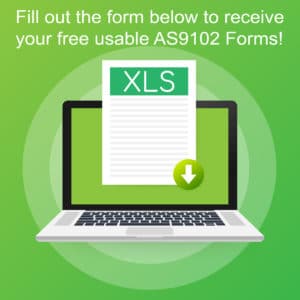AS9102 Standard: A Quick Guide 
Every manufacturing industry sector has its own requirements for production accountability, quality and parts inspection. However, none of these standards is more critical than those involved in aerospace and defense, where final products impact lives and livelihoods alike.
These requirements include First Article Inspection (FAI), which helps create a First Article Inspection Report (FAIR). All of this is governed by the optional AS9102 standard.
Learn more about this standard and how it impacts your FAI report process, inspection results and more.
Understanding AS9102 Requirements
AS9102 is a standard that emphasizes the value of the FAI process. Maintained by the Society of Automotive Engineers (SAE), the AS9102 standard is intended to separate planning and evaluation activities, define Digital Product Definition (DPD) and help manufacturing personnel manage product accountability throughout the production process.
AS9102 adds three required forms to the FAI report process:
- Form 1: Part Number Accountability — Identifies the production run and part or parts inspected in a FAIR.
- Form 2: Product Accountability — Accounts for any relevant specification, including those related to materials, testing and design requirements, production processes and more.
- Form 3: Characteristic Accountability — Notes dimensions, tolerances and other vital data in an inspection drawing or 3D model.
Necessary information includes:
- Part names.
- Part numbers.
- Serial numbers.
- FAIR numbers.
- Part revision levels.
- Certificate of Conformance number.
- Functional test procedure number.
- Acceptance report number.
- Reference locations.
- Characteristic designators.
- Inspection report results.
AS9102 Standard: Frequently Asked Questions
The AS9102 standard introduces new requirements to the First Article Inspection Report process. This leads to some important questions, including:
Are AS9102 and AS9100 Similar?
AS9100 is a quality management approach unique to the aerospace and defense industries. It includes FAI and FAI report processes.
AS9102 is the standard applied to this quality management system. It’s not a requirement but adds value to the inspection report process overall.
What’s the Difference Between AS9102A and AS9102B?
The original AS9102 standard, process and requirements were issued in 2000. Since then, the SAE has released three revisions:
- AS9102A or AS9102 Rev A.
- AS9102B or AS9102 Rev B.
- AS9102C or AS9102 Rev C.
The latter, which was released in 2023 and remains the most up-to-date version, includes information for DPD drawing requirements and 3D model data.
How Are AS9102 Inspections Performed?
An AS9102 inspection involves:
- Identifying a particular part or production run.
- Gathering drawings, specifications and any other relevant documents.
- Inspecting every detail before, during and after the production process.
- Documenting results in the appropriate form or forms.
- Compiling information in a finalized First Article Inspection Report (FAIR).
- Sharing the FAIR with the customer for verification.
What Is “Objective Evidence” in the AS9102 Requirements?
Many parts of AS9100 and AS9102 may ask for objective evidence. This is undeniable proof that the manufacturing and production process creates compliant parts based on:
- Drawing data.
- Production specifications.
- Customer expectations.
This evidence aims to help a customer understand the production process and how their needs are being met every step of the way. However, objective proof also helps manufacturing teams improve visibility across workflows and address non-conformity issues at their source.
What Happens if You Don’t Meet AS9102 Requirements?
Unlike other accountability, quality and production standards, AS9102 isn’t mandated. That means there won’t necessarily be direct ramifications for missing certain requirements; however, other issues — such as miscommunication with customers or non-conformity problems — could arise.
Overcoming AS9102 Inspection Challenges
An AS9102-compliant First Article Inspection Report requires numerous steps, which means there’s a significant margin of error. Challenges include:
- Capturing flawed or incomplete data.
- Using incorrect or inefficient data capture processes.
- Improperly combining or translating data from 3D and 2D drawings.
- Using the wrong form for certain information.
A single missed number or incorrect data point could compromise the reliability of an entire FAI report, leaving AS9102 requirements unmet. There’s also a noteworthy risk of production delays, parts issues and reduced customer satisfaction.
To overcome these challenges and more, manufacturing teams need AS9102 quality management software like DISCUS:
- DISCUS Excel Validator: This software automates FAI report tasks such as data capture and checking. It flags compliance or conformity issues and prevents finalized reports until each problem has been addressed, maintaining consistent quality across every form.
- DISCUS Desktop: If you want to reduce AS9102 turnaround times by up to 80%, this software is the best choice for your manufacturing process.
These solutions help improve accountability, manage quality, capture information from 3D and 2D drawings and more. The result is a smoother, faster inspection report process and higher-quality results — which, in turn, lead to more consistent production runs and better customer satisfaction.
Simplify Your AS9102 Inspection Process
AS9102 requirements may not be mandatory, but they introduce significant value to FAI reporting and quality management processes. It’s well worth the time and effort to review inspection processes and make targeted improvements — for example, by choosing the right software.
DISCUS solutions help meet AS9100 and AS9102 requirements across the manufacturing landscape, making data capture and reporting easier than ever. You’ll also enjoy reduced human error, increased efficiency, faster turnaround times and more.
Want to simplify AS9102 processes? Contact us today to learn more about DISCUS software.
